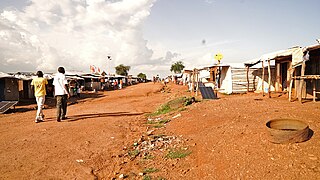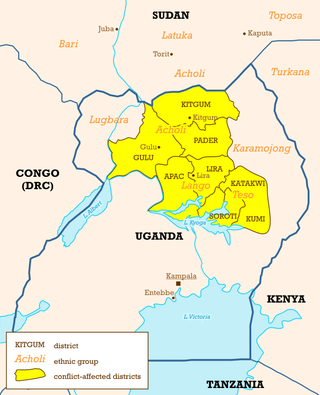
A refugee camp is a temporary settlement built to receive refugees and people in refugee-like situations. Refugee camps usually accommodate displaced people who have fled their home country, but camps are also made for internally displaced people. Usually, refugees seek asylum after they have escaped war in their home countries, but some camps also house environmental and economic migrants. Camps with over a hundred thousand people are common, but as of 2012, the average-sized camp housed around 11,400. They are usually built and run by a government, the United Nations, international organizations, or non-governmental organization. Unofficial refugee camps, such as Idomeni in Greece or the Calais jungle in France, are where refugees are largely left without the support of governments or international organizations.

Adjumani District is a district in Northern Uganda. Like most other Ugandan districts, it is named after its 'chief town', Adjumani, where the district headquarters are located.

Moyo District is a district in Northern Region of Uganda. Like many other Ugandan districts, it is named after its "chief town", Moyo, where the district headquarters are located.
Sudanese refugees are persons originating from the country of Sudan, but seeking refuge outside the borders of their native country. In recent history, Sudan has been the stage for prolonged conflicts and civil wars, as well as environmental changes, namely desertification. These forces have resulted not only in violence and famine but also the forced migration of large numbers of the Sudanese population, both inside and outside the country's borders. Given the expansive geographic territory of Sudan, and the regional and ethnic tensions and conflicts, much of the forced migration in Sudan has been internal. Yet, these populations are not immune to similar issues that typically accompany refugeedom, including economic hardship and providing themselves and their families with sustenance and basic needs. With the creation of a South Sudanese state, questions surrounding southern Sudanese IDPs may become questions of South Sudanese refugees.
By January 2011 the United Nations High Commissioner for Refugees (UNHCR) estimated that there are 262,900 Sudanese refugees in Chad. The majority of them left Sudan escaping from the violence of the ongoing Darfur crisis, which began in 2003. UNHCR has given the Sudanese refugees shelter in 12 different camps situated along the Chad–Sudan border. The most pressing issues UNHCR has to deal with in the refugee camps in Chad are related to insecurity in the camps,, malnutrition, access to water, HIV and AIDS, and education.
Kiryandongo Refugee Settlement is a refugee camp in Bweyale in Kiryandongo district Uganda.
The Koboko–Yumbe–Moyo Road is a road in the Northern Region of Uganda, connecting the towns of Koboko, Yumbe, and Moyo.

Rhino Camp Refugee Settlement is a refugee camp located in the districts of Madi-Okollo and Terego District in North Western Uganda.
Pagirinya Refugee Settlement is a refugee camp in Eastern Adjumani District in Northern Uganda.

Bidibidi Refugee Settlement is a refugee camp in the Yumbe District of northwestern Uganda. Home to over 270,000 South Sudanese refugees fleeing the ongoing civil war in early 2017, it was among the largest refugee settlements in the world at the time, and may have been the largest. As of 2018, that distinction was claimed by Kutupalong refugee camp for displaced Rohingya in Bangladesh.
Hakim Monykuer Awuok is a South Sudanese and he works as Deputy Director of Resolutions at the Ministry of Cabinet Affairs, South Sudan. He is also an AG/ Deputy Director Protocol, Public and External Relations, Ministry of Education, Science and Technology.

Uganda is one of the largest refugee-hosting nations in the world, with 1,529,904 refugees. The vast influx of refugees is due to several factors in Uganda's neighboring countries, especially war and violence in South Sudan and the Democratic Republic of the Congo, and associated economic crisis and political instability in the region. Uganda has relatively 'friendly' policies that provide rights to the refugees, such as rights to education, work, private property, healthcare and other basic social services.
Nyumanzi Refugee Settlement is a refugee camp in Adjumani District in northwestern Uganda. Established in 2014, it hosts about 52,000 South Sudanese refugees.
The Palorinya Refugee Settlement is a refugee camp in the Moyo District of the Northern Region of Uganda. The majority of the population fled the civil crisis in South Sudan in 2016.
Mungula II Refugee Settlement is a refugee camp found in Adjumani District Itirikwa subcounty in Northern Uganda.
Olua I Refugee settlement is a refugee camp in eastern Adjumani District in Northern Uganda. The Refugee settlement has its primary country as Uganda and other country south Sudan.
Oliji refugee settlement is a refugee camp in Adjumani District of Uganda.

The Maaji refugee settlements are three refugee camps located in Adjumani District in the Northern Region of Uganda, established in 1997. In June 2018, there were 41,764 registered refugees, accounting for 10% of the district's total population. It has primarily admitted refugees from the Second Sudanese Civil War and the ongoing South Sudanese Civil War. The settlements have been attacked several times by the Lord's Resistance Army, along with other camps in the region such as the Baratuku refugee settlement.
Ayilo 1 refugee settlement is a prominent refugee camp located in Adjumani District, situated in the Northern Region of Uganda.







